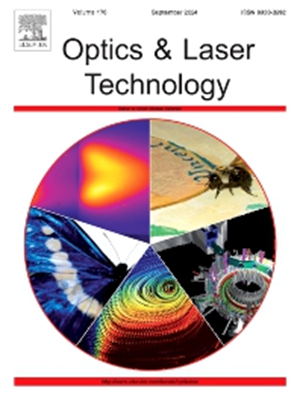Research on spatiotemporal dynamic speckle suppression mechanism in microstructured waveguide illumination DIC imaging
IF 4.6
2区 物理与天体物理
Q1 OPTICS
引用次数: 0
Abstract
Laser-illuminated imaging, capable of over-the-horizon detection, is extensively utilized in remote sensing and mapping of space, polar regions, and oceans. Under partly coherent laser illumination, random bright and dark patches caused by phase change of light waves due to minute optical path difference in differential interferometric contrast imaging, hence diminishing image quality. This paper investigated the phase-modulated speckle suppression mechanism under partially coherent light and proposed a spatio-temporal dynamic speckle autocorrelation suppression method using microstructured waveguides. By enhancing the conventional reflective differential interference contrast imaging systems with a partially coherent laser as the illumination source and incorporating a point-array microstructure device, spatio-temporal dynamic experiments were conducted through the integration of beam angle and displacement transformations. The results demonstrated that Ir-coated, curved surface-like dot-array homogenizing devices which assisted in imaging effectively achieve spot homogenization and uniform energy distribution, leveraging the scattering suppression capabilities inherent in their material and structural design. In both air and underwater environments, when the light source was uniformly translating or rotating and reached the autocorrelation threshold, the scattering optical range difference was most uniformly distributed; at the same time, when the angle of incidence reached the autocorrelation threshold, the coherence width of the light field was largest, the phase difference was smallest, and the imaging quality was best. Especially in the underwater imaging experiments, the proposed microstructure design combined with the dynamic modulation of the light source demonstrated superior scattering suppression capability, providing an effective way to improve underwater imaging quality.
微结构波导照明 DIC 成像中的时空动态斑点抑制机制研究
本文章由计算机程序翻译,如有差异,请以英文原文为准。
求助全文
约1分钟内获得全文
求助全文
来源期刊
CiteScore
8.50
自引率
10.00%
发文量
1060
审稿时长
3.4 months
期刊介绍:
Optics & Laser Technology aims to provide a vehicle for the publication of a broad range of high quality research and review papers in those fields of scientific and engineering research appertaining to the development and application of the technology of optics and lasers. Papers describing original work in these areas are submitted to rigorous refereeing prior to acceptance for publication.
The scope of Optics & Laser Technology encompasses, but is not restricted to, the following areas:
•development in all types of lasers
•developments in optoelectronic devices and photonics
•developments in new photonics and optical concepts
•developments in conventional optics, optical instruments and components
•techniques of optical metrology, including interferometry and optical fibre sensors
•LIDAR and other non-contact optical measurement techniques, including optical methods in heat and fluid flow
•applications of lasers to materials processing, optical NDT display (including holography) and optical communication
•research and development in the field of laser safety including studies of hazards resulting from the applications of lasers (laser safety, hazards of laser fume)
•developments in optical computing and optical information processing
•developments in new optical materials
•developments in new optical characterization methods and techniques
•developments in quantum optics
•developments in light assisted micro and nanofabrication methods and techniques
•developments in nanophotonics and biophotonics
•developments in imaging processing and systems

 求助内容:
求助内容: 应助结果提醒方式:
应助结果提醒方式:


